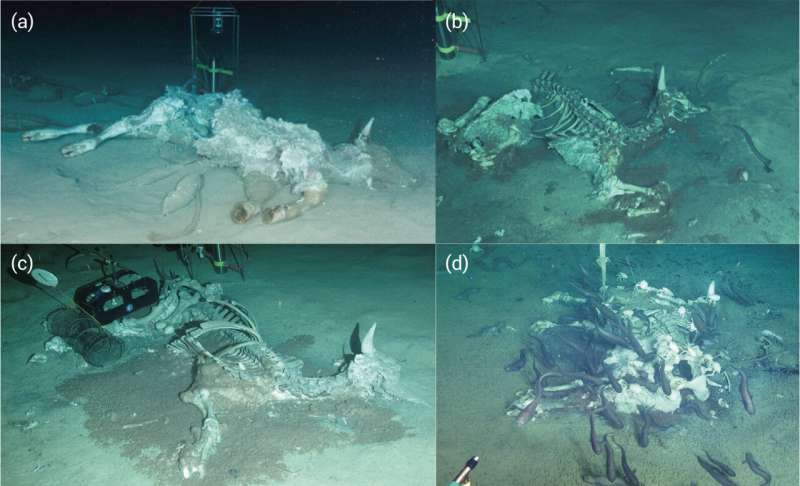This article has been reviewed according to Science X's editorial process and policies. Editors have highlighted the following attributes while ensuring the content's credibility:
fact-checked
proofread
Researchers conduct whale fall studies in the South China Sea

In the late 1980s, scientists discovered that when a whale dies, its carcass sinks to the ocean bottom and a new ecosystem springs forth around the carcass. The carcass becomes a food source for this new ecosystem. A team of researchers recently undertook a study of whale falls in the South China Sea. In the absence of actual whale falls, they conducted simulated whale fall experiments using cow carcasses.
Their work was published in the journal Ocean-Land-Atmosphere Research on February 23, 2023.
Since 1987 when the first whale fall was discovered, most of the whale falls have been found in the Pacific Ocean along the California coast. These whale falls are difficult to locate, and since 1987, less than 30 natural whale falls have been reported in scientific journals.
The ecosystems that occur around a whale fall represent unique biodiversity hotspots. The transient deep marine life that flourishes in these ecosystems is different than those communities found around other features on the ocean floor, such as hydrothermal vents, cold seeps, and cold water coral. The whale falls attract deep-sea creatures that are otherwise difficult to find.
In 2020, the research team discovered a whale fall on the slope of a sea mountain in the South China Sea, while conducting studies with the human-operated vehicle SHENHAIYONGSHI. The whale fall was identified as a dolphin species, and the researchers installed a camera there to take photos every day for two months.
The series of photos revealed the carcass colonized by diverse deep-sea creatures including shrimp, sea urchin, crab, snailfish, fish, and eel. As the carcass moved through different stages of decomposition, there were different creatures living in the whale fall ecosystem. A year and a half later, the team made another dive and discovered that the carcass had nearly disappeared, except for a few bone pieces.
The discovery of that whale fall raised many interesting questions for the researchers. The scientists wondered whether the animals identified during the different stages of decomposition were distinct from those identified in whale falls in other ocean regions, whether they were distinct from animal species typically found in the deep South China Sea, and how these mobile animals survive between whale falls.
"We undertook the study to reveal if whale fall communities in the South China Sea are different from other regions and if there are any endemic species of the whale falls in South China Sea," said Kedong Yin, a professor at Sun Yat-sen University.
Because the whale fall found in the South China Sea in 2020 was located on the slope of a sea mountain in a deep ocean basin, the team specifically wanted to explore how the water depth affected the species that gathered at the whale fall community. They wondered how species coming to the whale fall from different ocean depths adjusted to the pressure changes. No studies have ever been conducted to specifically examine how ocean depth affects the composition of the whale fall community.
The team used cow carcasses, that have been shown to successfully mimic natural whale falls in other areas, to conduct tests on the Zhongnan seamount in the South China Sea. They positioned three cow carcasses weighing about 600 kilograms each at depths of 650, 1,600, and 3,400 meters on the seamount. They placed a camera, video camera, and other instruments there to observe the carcasses.
The team's analysis of the preliminary data reveals a strong dissimilarity between the whale fall communities at different ocean depths. This suggests there is a significant seamount effect on whale fall ecosystems. The team also found many species that had not been previously reported in the South China Sea. It is very clear that whale falls are an important oasis for sustaining deep-sea life, with more than 400 visible species relying on the whale fall ecosystems.
Looking to the future, with the large number of seamounts located in the South China Sea, the team plans for more studies. "We want to further investigate communities of whale falls in the different depths of the mountain slope and develop our observation equipment to a common deep-sea biodiversity observatory platform," said Yin.
More information: Kedong Yin et al, Experimental Whale Falls in the South China Sea, Ocean-Land-Atmosphere Research (2023). DOI: 10.34133/olar.0005
Provided by Ocean-Land-Atmosphere Research (OLAR)



















